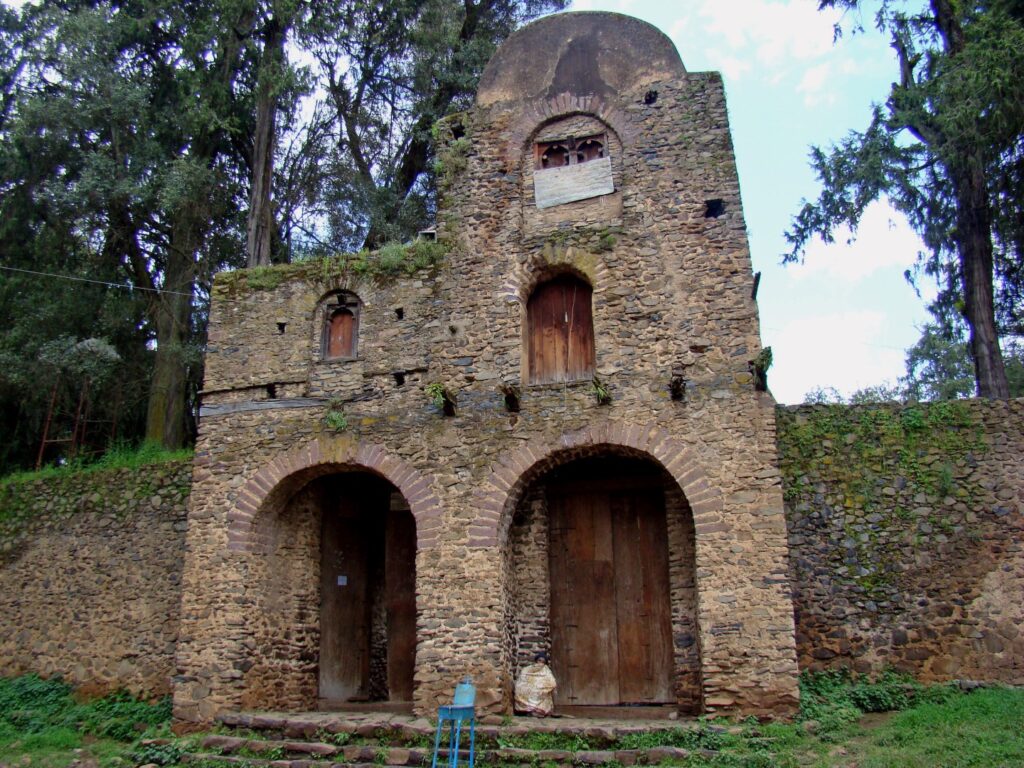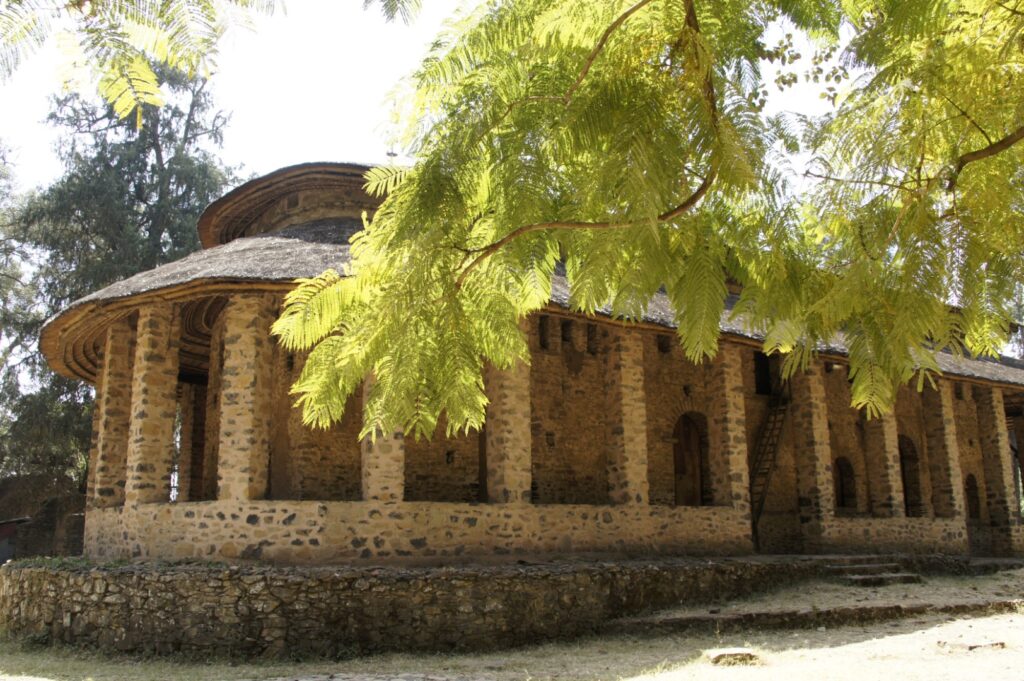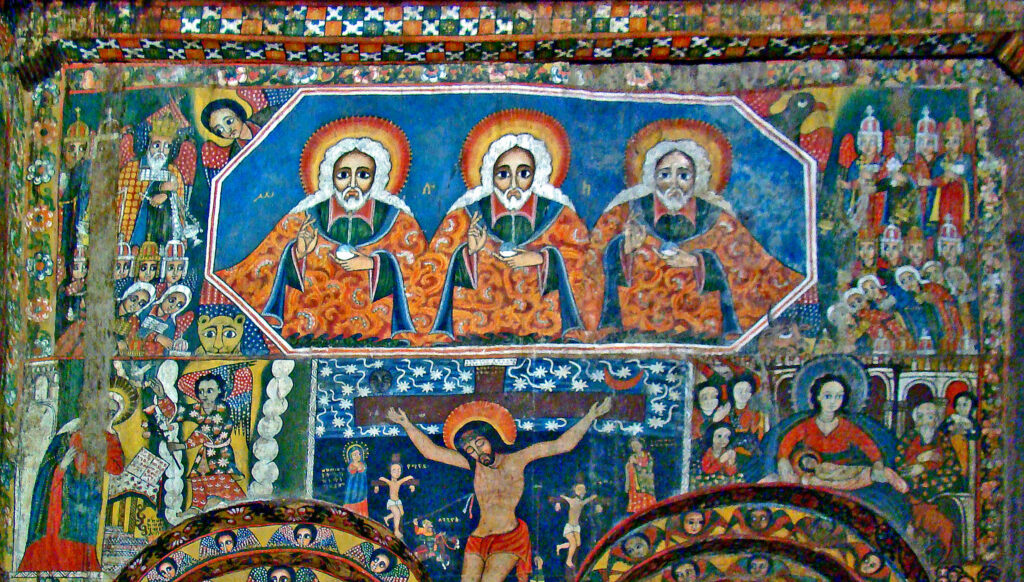

type: RECENTLY BUILT CHURCH
RECTANGULAR PLAN
17th CENTURY AND LATER
during the reign of Iyasu 1 (1682 – 1706) the church had been consecrated around 1694. like two other gonderine churches, i.e. debre sina maryam and narga selassi, it presumably had a circular floorplan. it was destroyed and later rebuilt by negus egwada seyon (1801 – 1818). their portraits can be seen on the north wall inside.
the gatehouse is integrated in the stone wall that surrounds the compound.

westside of the church, opposite the gatehouse. it has a rectangular floorplan, so there is no makdas. the inner wall is surrounded by a colonnade of square columns, resulting in a double pitched, thatched roof.

all ethiopian churches are oriented, meaning that the sanctuary is in the east, the main entrance in the west. in this case the tabot is located in the circular apse. as explained before the tabot is a copy of the arc of the covenant, containing the ten commandments. moses received the original arc from the hands of god on mount sinai. as soon as this holy of holies leaves the church, the building is no longer sacred.

the construction of the roof follows the line of the main building. an assembly of reed and wood is supported by the wall and the square columns. a glimpse of two columns can be seen on the far left and right of the picture.

the east wall inside the church separates the sanctuary from the public space. its colorful, festive sight is overshadowed by the damage done by rainwaters. the person on the right of the trinity (=selassi) has lost his luster, so he does not look very satisfied. it seems that his part of the cloth had been saturated with water for some time. when it dried the cloth has shrunk, distorting the image.
the left side of the wall shows a large part where the paint has been washed away completely. too bad for the angel gabriel’s annunciation of mary’s pregnancy.

the composition of the crucifixion is dictated by the architecture. mary is present on the far left but john is missing. he is always there to comfort mary at the moment her son dies, or to close her in his arms when she is in danger of fainting. the person on the right is probably maria salome. stephaton’s stick is way too short to get the vinegar soaked sponge anyway near jesus’ mouth. the dwarf longinus on his flying horse succeeds miraculously in piercing jesus’side.
this crucifixion is a grotesque cartoon and merits our scorn.

the birth scene on top of the right door is attended by two angels, mary salome with a bad wolf on her shoulder, a zebu, a shepherd holding a dog and saint joseph the foster father. he looks down, somewhat ashamed. mother mary has no contact with her unattractive baby and vice versa. she holds her child like a lump of meat, emotionless, staring into a distant void.
lucky enough the average beholder is too far removed from the criticized details to recognize them.

the uniqueness and beauty of this painting overrules any criticism. from the ceiling about 150 cherubs watch the beholder. lie down on your back and stare in the opposite direction for some minutes. the hallucinating beauty of this phenominal painting will forever stay engraved in your mind.

in the north-east corner saint george, riding a gorgeous white horse, is slaying the dragon. the monster was threatening a young princess from beirut called beirutawit. george tamed the dragon, put a rope around its neck and handed the animal over to the princess. she walked home with it as a present for her father the king.
to the right the madonna and child, as usual safeguarded by the angels gabriel and michael. but who is the prostrated figure at her feet?

the crown lying next to him on the floor tells that he is a king. indeed he is the negus iyasu 1, who had the first debre birhan selassi church built. he is supported by the nine syrian saints. they also had many churches bult in ethiopia during the 5th and 6th centuries. all nine turn their eyes at the east wall, at the trinity and the crucifixion, results of their missionairy activities!

here is another prostrated king. his name is egwada seyon. he had the present berhan selassi church built. the negus is lying at the foot of the famous saint tekle haymanot.
the popular, vernacular saint tekle haymanot can be found in public buses, in market places and in most churches. he is the only ethiopian saint venerated also in roman catholic and coptic environments.
he used to withdraw in meditaton and prayer for hours at end. he stood so long praying, 34 years, that he broke a leg. seven more years he remained standing on one foot. to relieve him the good lord favored the saint with three pairs of wings.
in order not to fall asleep and to stay upright tekle haymanot had spikes installed on both sides of his narrow cell. his broken leg is painted rather clumsily. the contours are still there, filled in with brown paint. in most other paintings the leg is clearly visible, standing against the wall. here the negus is clasping the pure white withered leg, in his left hand. he might be asking for a favour.

tekle haymanot had been studying at the debre damo monastery for years. when he had finished his studies, he left the table mountain in the usual way. however a jealous devil cut the rope while the saint was descending. he was about to crash when, just in time, the three pairs of wings, a former gift of god, emerged on his back.
he made a perfect, soft landing on the rocky bottom.
the second register on the west wall, contains paintings not in sequential order. underneath we even see two stories, within one frame, but they have nothing in common. such madness will only lead to misunderstanding.

according to the christian ethiopian church, a man called gigar was the first christian martyr. undisputed champion in making martyrs was king herod. he ordered the massacre of the innocents. he had john the baptist beheaded as a present for his step daughter salome, because of her sexy dancing. here he attends the decapitation of gigar. the king and his executioner are both depicted in profile, one eyed and ugly, as usual for the bad guys in ethiopian art. on the spot where gigar’s head landed, a flowering tree sprouted, which could not be felled, nor burned, nor smothered.
during the flight into egypt, mary notices that the waterbottle is getting empty. they knock on the door of a well to do family. the lady of the house, timan, had observed from her room on the second floor, what happenened. she orders her servant kotiva, to chase those slobs away. when joseph insists, kotiva gets irritated, rips jesus from salome’s arms and throws him onto the ground. shocked by so much aggression, mary, josef and salome watch the poor child. jesus is only furious and takes revenge by making timan fall from her window. she hits the ground, causing a hole deep enough to bury her and kotiva alive. all other residents undergo a transfiguration. monkeys and dogs they become. they bite each other’s tail off and flee into the desert.
which parts of the text do you recognize in the picture?!
